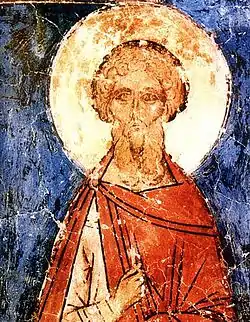Saint Julian of Antioch | |
|---|---|
 | |
| Martyr | |
| Died | ~305 AD |
| Venerated in | Eastern Orthodox Church Roman Catholic Church |
| Feast | June 21 (Eastern Orthodox); March 16 (Roman Catholicism) |
| Attributes | portrayed as being cast into the sea in a sack full of serpents and scorpions. He may also be shown as his coffin floats with four angels seated on it, or being led bound on a dromedary. |
Julian of Antioch (Latin: Julianus, Greek: Ίουλιανός; d. AD 305 x 311),[1] variously distinguished as Julian the Martyr, Julian of Tarsus, Julian of Cilicia, and Julian of Anazarbus, was a 4th-century Christian martyr and saint. He is sometimes confused with the St Julian who was martyred with his wife Basilissa.
Life
Of senatorial rank, he was killed during the persecutions of Diocletian.
His legend states that he was subjected to terrible tortures, and paraded daily for a whole year through the various cities of Cilicia. He was then sewn up in a sack half-filled with scorpions, sand, and vipers, then cast into the sea. The waters carried his body to Alexandria, and he was buried there before his relics were translated to Antioch.[2]
Veneration
Saint John Chrysostom preached a homily in Julian's honor at Antioch,[2] whose chief basilica was said to be the final resting place for Julian's relics and was known in his honor.
His feast day is June 21 in the Eastern Orthodox Church, and March 16 in the Catholic Church.
See also
References
- ↑ "Julian von Tarsus (Von Cilicien) - Ökumenisches Heiligenlexikon".
- 1 2 Rizos, Efthymios (2021). "Saint Julian of Cicilia: Cult and Hagiography Including the Edition and English Translation of the Passio S. Iuliani Anazarbeni (BHG 966) and its Epitome (BHG 967d)". Analecta Bollandiana. 139 (1): 106–155. doi:10.1484/j.abol.5.126691. ISSN 0003-2468. Retrieved September 9, 2022.
External links
- Saints of March 16 Archived October 6, 2010, at the Wayback Machine
- Lives of the Saints: Julian of Tarsus